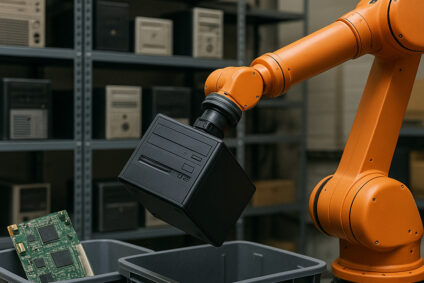Understanding the Different ITAD Options: Recycling, Resale, and More
Are you tired of old or outdated IT equipment cluttering up your space? Do you want to dispose of it properly but have no idea where to start? Don’t fret, we’ve got you covered! In this blog post, we’ll delve into the world of IT Asset Disposition (ITAD) and help you understand the different options available. From recycling to resale and beyond, we’ll explore each method in detail so that you can make an informed decision on which option is best for your business or organization. So sit back, relax, and let’s dive into the wonderful world of ITAD!
What is ITAD?
ITAD stands for Information Technology Asset Disposition. ITAD is the process of disposing of or recycling electronic equipment and devices that are no longer needed or wanted.
There are several different ITAD options available, including recycling, resale, and donation. Each option has its benefits and drawbacks, so it’s important to choose the right one for your needs.
Recycling is a good option if you want to ensure that your old equipment is properly disposed of and doesn’t end up in a landfill. However, it’s important to make sure that you use a reputable recycling company that will recycle your equipment responsibly.
A resale is a good option if you’re looking to get some money back for your old equipment. There are many online marketplaces where you can sell used electronics, but it’s important to do your research before listing anything for sale. Make sure you know what your equipment is worth and set a fair price.
A donation is a great option if you don’t need the money from selling your old equipment and you want to help somebody in need. Many organizations accept donations of used electronics, so do some research to find one that accepts the type of equipment you have.

The Different Types of ITAD Services
There are a few different types of ITAD services, each with its own set of benefits. Here’s a quick overview of the most popular options:
Recycling: This is the most environmentally friendly option, as it involves breaking down the materials in your devices so they can be used to create new products. It’s also usually the most affordable option.
Resale: If your devices are still in good working condition, you may be able to sell them for a profit. This is a good option if you’re looking to upgrade to newer models and want to offset the cost.
Refurbishment: Similar to recycling, this involves breaking down the device and then rebuilding it with new or refurbished parts. This is typically more expensive than recycling, but it can extend the life of your devices significantly.
Data destruction: This is an important step in any ITAD process, as it ensures that all data on your devices is securely wiped before they’re disposed of or sold. This is usually done through physical or digital shredding or degaussing (a process that uses magnetic fields to destroy data).
Pros and Cons of each ITAD Option
When it comes to IT asset disposition (ITAD), there are a few different options available. Each option has its own set of pros and cons that should be considered before making a decision. Here is a closer look at the recycling, resale, and donation options:
Recycling:
Pros:
-Recycling is often the most environmentally friendly option for disposing of IT assets.
-It can also be one of the most cost-effective options, depending on the value of the materials being recycled.
-Many recyclers will also handle data destruction, which can take some of the burdens off your organization.
Cons:
-There is always the risk that sensitive data could be leaked during the recycling process.
-Some recyclers may not be properly certified or insured, which could leave your organization liable if something goes wrong.
-You may not get any financial compensation for your recycled materials.
Resale:
Pros:
-Selling your used IT assets can generate some revenue for your organization.
-It can also be a more eco-friendly option than simply throwing them away.
-You can typically choose who you sell your assets to, which gives you some control over what happens to them after they leave your hands. Cons: -It can be difficult to find buyers for certain types of used equipment. -You may need to invest in cleaning and testing the equipment before you can sell it. -There is always the risk that sensitive data could be leaked during the process of selling your IT assets.
Donation:
Pros:
-Donating your used IT assets can be a great way to help those in need while also helping the environment.
-It can also be a tax-deductible option for organizations looking to reduce their expenses.
-You may receive some recognition or publicity for donating your IT assets, which could benefit your organization’s reputation.
Cons:
-You may not be able to choose to who you donate your assets, so there is always a chance that they may end up in the wrong hands.
-The recipients of donated IT assets may not have the resources or capabilities to properly handle them, which could lead to further problems down the line.
-Data destruction is typically not included with donations, so you would need to take care of this yourself if you want to ensure that sensitive data remains secure.

How to Get Started with ITAD for your company?
If you’re looking to get started with ITAD for your company, the first thing you need to do is decide what type of ITAD services you want to use. There are three main types of ITAD: recycling, resale, and disposal.
Recycling is the most common type of ITAD, and it involves breaking down old electronics and components so that they can be used to create new products. This is a great option if you’re looking to reduce your carbon footprint and help the environment.
Resale is another popular option for ITAD, and it involves selling your old electronics to companies or individuals who are interested in buying them. This is a great way to make some extra money while also getting rid of old electronics that you no longer need.
Disposal is the least common type of ITAD, but it’s often the best option for electronics that are no longer usable. Disposal ensures that your old electronics are properly disposed of and recycled so that they don’t end up in a landfill.
Once you’ve decided which type of ITAD services you want to use, the next step is to find a reputable company that offers these services. There are many different ITAD companies out there, so it’s important to do your research and find one that fits your needs.
Once you’ve found a reputable company, the next step is to contact them and set up an appointment. During this appointment, the company will come to your
What Happens to Your Data When You Use ITAD Services?
There are a few different things that can happen to your data when you use ITAD services. One is that it can be erased so that it can’t be accessed by anyone else. This is usually done using special software that overwrites the data multiple times. Another option is for the data to be destroyed physically, which makes it impossible to retrieve. This is usually done by crushing or shredding the storage media.
Another possibility is that the data can be sold to another company or individual. This often happens with older devices that still have valuable data on them. The new owner will then erase the data and use the device for their purposes. Finally, some companies offer recycling services for old devices. This means that the data will be wiped and the device will be refurbished and resold.
Conclusion
ITAD services offer various methods for disposing of unwanted tech equipment, from recycling and reselling to donation or destruction. Each option is tailored to fit the individual needs of your company and provide a clean, safe solution that meets legal requirements. Although it can be difficult to choose between all the different types of ITAD options, understanding each one in detail can help you make an informed decision when selecting the right one for your business.







